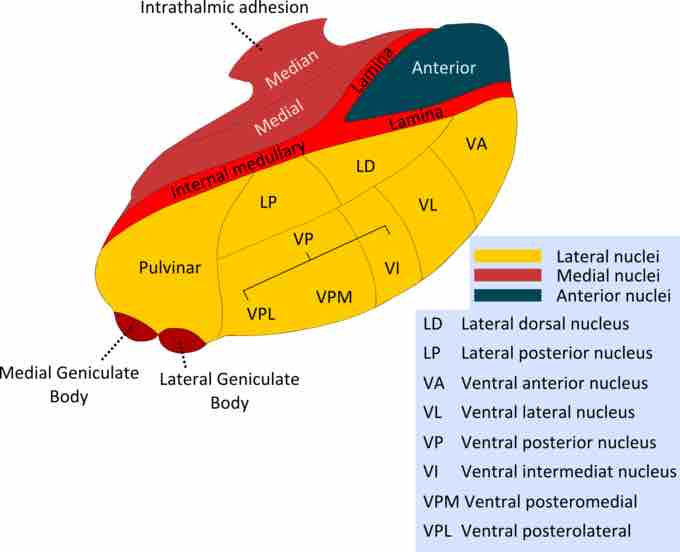The thalamus (derived from the Greek meaning "inner chamber") is a midline symmetrical structure within the brain, situated between the cerebral cortex and midbrain. Its functions include relaying sensory and motor signals to the cerebral cortex and regulating consciousness, sleep, and alertness. The thalamus surrounds the third ventricle and is the main product of the embryonic diencephalon.
Overall Structure of the Thalamus
Each half of the thalamus is about the size and shape of a walnut: approximately 3 centimeters long, 2.5 centimeters across at the widest point, and about 2 centimeters high. Together, the two halves of the thalamus are a prominent bulb-shaped mass, about 5.7 cm in length, located obliquely (about 30°) and symmetrically on each side of the third ventricle.
The thalamus is part of a nuclear complex of composed of four parts: the hypothalamus, epithalamus, the ventral thalamus, and the dorsal thalamus. The thalamus has a system of myelinated fibers that separate the different thalamic subparts. These areas are defined by distinct clusters of neurons.
The thalamus derives its blood supply from four arteries including the polar artery (posterior communicating artery), paramedian thalamic-subthalamic arteries, inferolateral (thalamogeniculate) arteries, and posterior (medial and lateral) choroidal arteries. These are all derived from the vertebrobasilar arterial system except the polar artery. The thalamus is connected to the hippocampus via the mammillothalamic tract.

The Nuclei of the Thalamus
The graphic details the various nuclei of the thalamus.
Primary Functions of the Thalamus
The thalamus has multiple functions, serving as a sort of switchboard of information. It is generally believed to act as a relay between a variety of subcortical areas and the cerebral cortex. In particular, every sensory system (with the exception of the olfactory system) has a thalamic nucleus that receives sensory signals and sends them to the associated primary cortical area. For the visual system, for example, inputs from the retina are sent to the lateral geniculate nucleus of the thalamus, which in turn projects to the primary visual cortex in the occipital lobe. The thalamus is believed to both process and relay sensory information. Each of the primary sensory relay areas receives strong back projections from the cerebral cortex. Similarly, the medial geniculate nucleus acts as a key auditory relay between the inferior colliculus of the midbrain and the primary auditory cortex. The ventral posterior nucleus is a key somatosensory relay, which sends touch and proprioceptive information to the primary somatosensory cortex.
The thalamus also plays an important role in regulating states of sleep and wakefulness. Thalamic nuclei have strong reciprocal connections with the cerebral cortex, forming thalamo-cortico-thalamic circuits that are believed to be involved with consciousness. The thalamus plays a major role in regulating arousal, awareness level, and activity. Damage to the thalamus can lead to permanent coma. Fatal familial insomnia is a hereditary prion disease characterized by degeneration of the thalamus and leading to a gradual progression to a state of total insomnia that is eventually fatal.